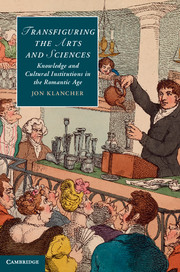Press Release: Carnegie Mellon's Jon Klancher Authors Book On How Romantic Era Transformed Arts and Sciences
Contact: Shilo Rea / 412-268-6094 / shilo@cmu.edu
 PITTSBURGH—The Romantic era may be best known for artistic free expressions, but a new book by Carnegie Mellon University's Jon Klancher shows how the period during the 18th and 19th centuries transformed the arts and sciences into the disciplines used today.
PITTSBURGH—The Romantic era may be best known for artistic free expressions, but a new book by Carnegie Mellon University's Jon Klancher shows how the period during the 18th and 19th centuries transformed the arts and sciences into the disciplines used today.
Published by Cambridge University Press, "Transfiguring the Arts and Sciences: Knowledge and Cultural Institutions in the Romantic Age" offers an original study of how new research and educational organizations reconstructed the idea of knowledge, revealing a more complicated history between the arts and sciences than previously thought.
Klancher, a professor of English in CMU's Dietrich College of Humanities and Social Sciences, takes a historical and cross-disciplinary approach to opening up Romantic literary and critical writing to transformations in the history of science, history of the book, art history and the little-known history of arts and sciences administration and their connection to modern organization of knowledge.
To really understand how the relationship between the arts and sciences changed, Klancher investigated and traced the influence of poets, lecturers, moral philosophers, scientists and literary critics, including Samuel Taylor Coleridge, William Wordsworth, William Godwin and Jeremy Bentham. Klancher also uncovered unprecedented public access and impact to the art and sciences debate through a vivid lecturing scene.
"The new cultural institutions reached out to the public and engaged them in discussions about the ongoing arts debates and scientific controversies," Klancher said. "There were constantly changing arguments about what the sciences are, where poetry fits in, how print media and the visual arts were transforming the shapes of public knowledge and spectatorship. These added up to a reconfiguration across British culture of the Enlightenment meaning of 'arts and sciences.' Within that phrase were articulated many of the disciplinary and interdisciplinary questions we still ask today."
Another discovery that Klancher made was the cultural role administrators played in the new institutions and how they reworked relations between the various arts and sciences of the age. "We have no cultural history of administration," Klancher said. "And, I've tried to begin one by studying how such administrators emerged to become cultural producers in their own right. As Adorno once put it, administrators are often too far from the knowledge fields they try to control or stimulate. Yet there is no such thing as intellectual or artistic culture without administration, and we have yet to grasp that paradox in the history of our knowledge."
Klancher, director of the Department of English's Literary and Cultural Studies Program, focuses on Romantic and Victorian studies, history of books and reading, and the sociology of cultural fields. His previous book, "The Making of English Reading Audiences 1790-1832," drew a new picture of the Romantic era in England by showing the reading patterns, interpretive frameworks and socio-political relations of new reading audiences during the time period.
For more information on or to purchase a copy of "Transfiguring the Arts and Sciences," visit http://www.amazon.com/Transfiguring-Arts-Sciences-Institutions-Romanticism/dp/1107029104.
###
"Transfiguring the Arts and Sciences: Knowledge and Cultural Institutions in the Romantic Age," by CMU English Professor Jon Klancher, offers an original study of how new research and educational organizations reconstructed the idea of knowledge, revealing a more complicated history between the arts and sciences than previously thought.